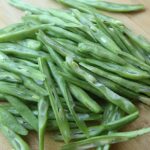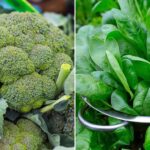So, how long do you boil broccoli to cook it perfectly while retaining its crisp texture and vibrant green color? Find out by following the instructions below.
Preparation:
– 1 broccoli
– Salt
Instructions:
Step 1: Clean the Broccoli
Cut the broccoli into small, evenly sized florets. Alternatively, you can carefully separate the florets by hand. Ensure that the florets are of similar size so that they cook evenly during boiling.

Soak the broccoli in water mixed with rice starch for about 10-15 minutes, adding a pinch of salt. Rice starch water contains acids that help remove pesticide residues and effectively absorb impurities. The salt also aids in cleaning by attracting dirt, insect eggs, and debris that may be present in the broccoli florets.
When soaking, place a rack or a plate over the broccoli to ensure it is fully submerged. Afterward, rinse the broccoli thoroughly under clean water two to three times to eliminate any remaining impurities.

Step 2: Boiling
Bring a pot of water to a rolling boil and add a teaspoon of salt.
Once the water is boiling, carefully add the broccoli. Leave the lid off and let the broccoli boil for 2-3 minutes. Occasionally stir the broccoli to ensure even cooking. After this time, the broccoli should be cooked yet still crisp and bright green. Immediately remove the broccoli from the pot and place it on a plate.
Depending on the size of the broccoli, you may need to adjust the boiling time. For a medium-sized broccoli, 3 minutes is ideal. If you have a larger broccoli, you may need to add an extra 30 seconds or more. For smaller broccoli, 2 minutes should be sufficient.
Overboiling will cause the broccoli to turn yellow and become soft, indicating overcooking.
Now that your broccoli is perfectly boiled, you can enjoy it as a side dish or use it to create delicious salads.

Good luck!
Delicious and Easy-to-Make Dishes with Lotus Stem
The delicate yet versatile water caltrop, or water chestnut, is a culinary treasure, adding a unique and nutritious touch to a variety of dishes. From crisp, refreshing salads to hearty soups, the water caltrop is a true chameleon, enhancing the flavor and nutritional profile of any dish it graces. With its subtle sweetness and crisp texture, it is no wonder that this humble ingredient has earned a place in the hearts and kitchens of food enthusiasts and health-conscious individuals alike.
The Ultimate Guide to Making Delicious Dried Shrimp Powder: A Long-Lasting Treat
“Ruốc, or Vietnamese shrimp paste, is a versatile ingredient in Vietnamese cuisine. It is not only a delicious side dish but also a key component in a myriad of recipes. Discover how to make a simple dry-fried ruốc that will last for a long time. A staple in many Vietnamese households, this umami-rich condiment will elevate any meal.”
5 Vegetables You Should Parboil to Remove Toxins and Ensure Family Health
In cooking, not all vegetables can be prepared as is; some may contain harmful substances that can be detrimental to our health. It is imperative to understand the intricacies of each vegetable and the potential toxins they may harbor. By doing so, we can ensure that our culinary creations are not only delicious but also safe and nourishing.



































